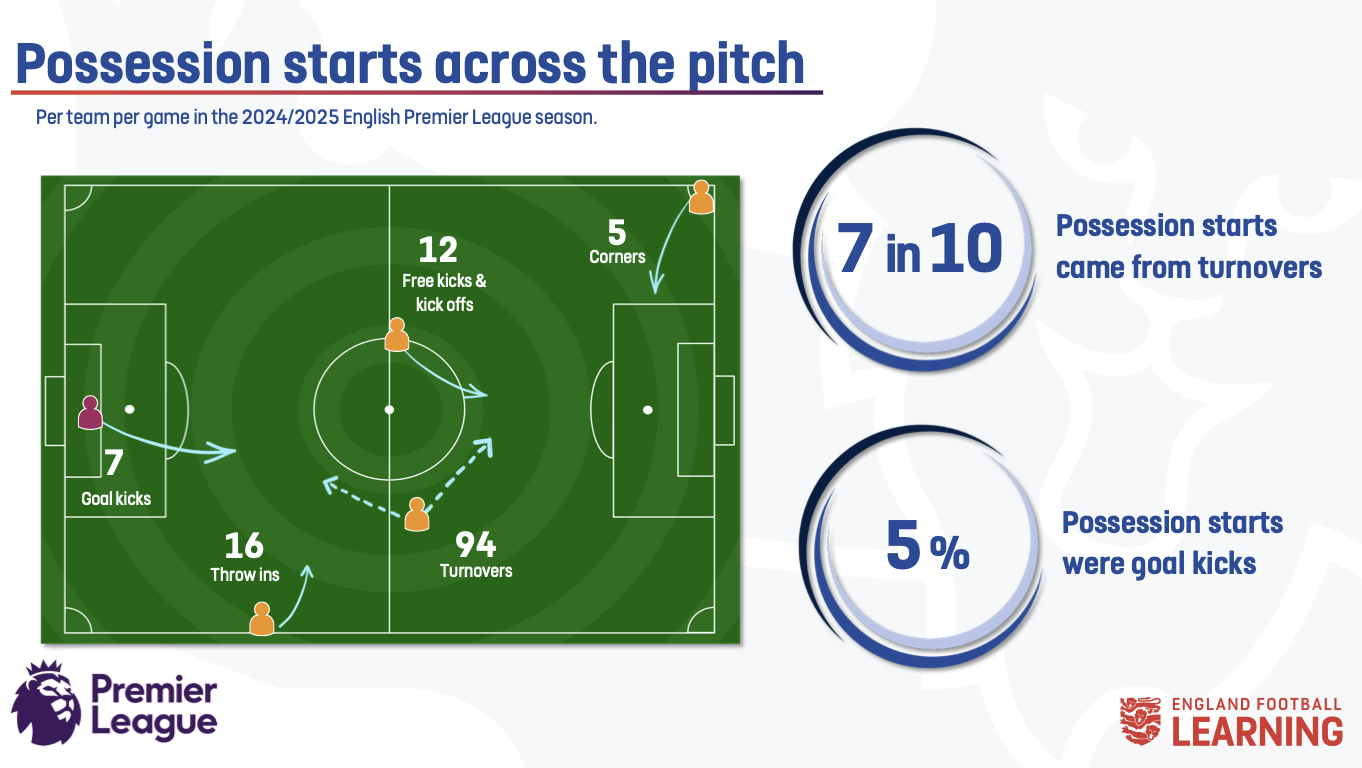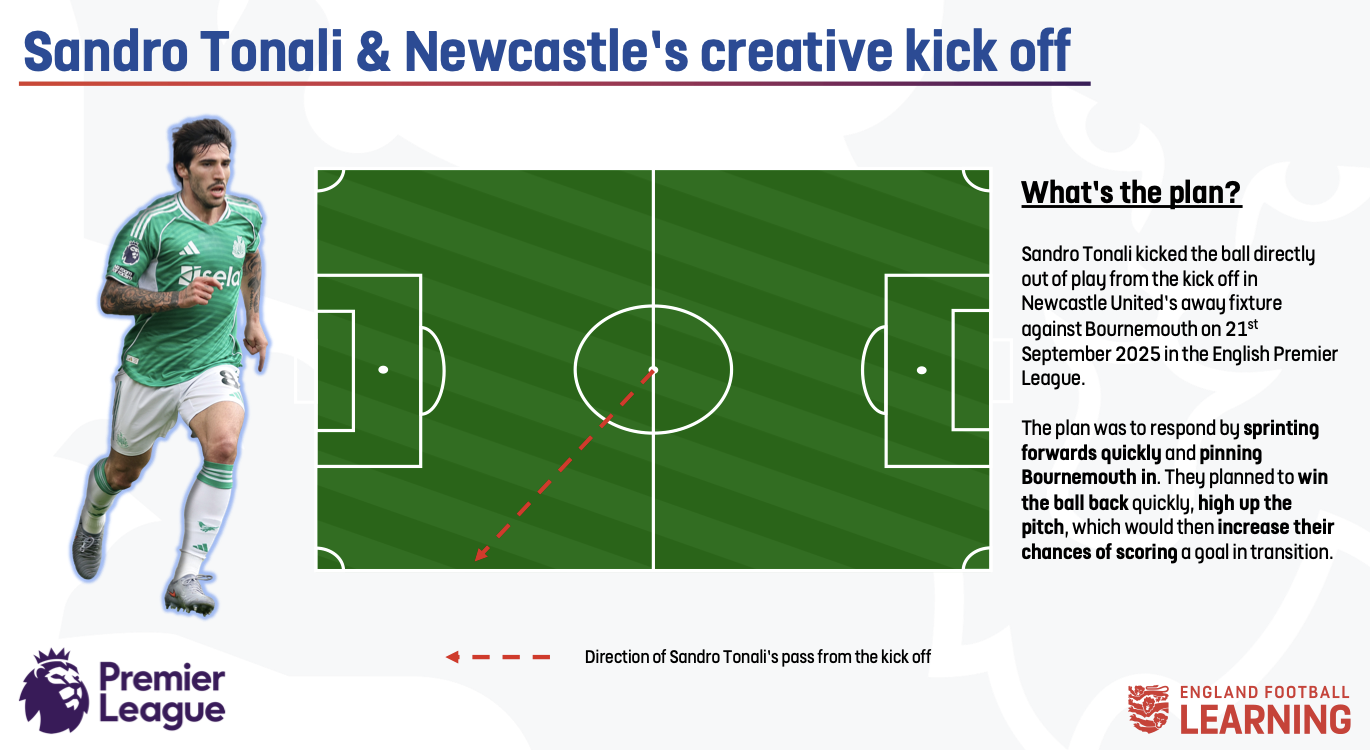What is stopping us from being creative with our set plays? Can we think outside of the box and get inventive further back on the pitch? Game Insights analyst Luke Saunders and Senior Pro Game Coach Developer Steve Greaves examine a few set play routines from the 2025/26 English Premier League season.
Possession starts and set plays
Steve Greaves starts us off with some engaging thoughts and questions:
“If you value set plays of any sort, you need to dedicate practice time to them. This gives you time to focus on more areas of the 4 corner model, rather than just the technical skill. Are you just copying what you see on TV, or are you considering your players’ capabilities? These considerations apply to both in possession and out of possession during set plays.”
To give an understanding of how often teams use set plays, let’s look at how many occurred in the 2024/2025 English Premier League (EPL) season on average.

Traditionally, we view set plays as corners and free kicks that are high up the pitch. These provide a greater opportunity to get a shot on goal due to their location. Are we missing opportunities by ignoring other set plays?
Kick offs
We have seen teams try different ways to kick off the game and put their opponents under pressure instantly. The plan is simple: get the ball where it’s most dangerous and make the opponents defend. A few examples are:
- Long kick off played backwards to the goalkeeper, who is in the middle 3rd of the pitch. They send a long pass into the attacking 3rd for a teammate to challenge an aerial duel (e.g. Jordan Pickford for Everton).
- Short kick off played backwards to a teammate within the centre circle who flicks the ball up and volleys it high into the air. The ball lands around the opponent’s 18-yard box for an aerial duel (e.g. Alex Scott for Bournemouth).
- Long kick off played forwards towards the opponent’s corner flag to send the ball directly off the pitch. The opponents have a throw in deep inside their own half (e.g. Sandro Tonali for Newcastle United).

Sandro Tonali started Newcastle’s away game against Bournemouth by sending the kick off directly out of play for a throw in. Before Bournemouth can set up, Newcastle United swarm up the pitch to pin them into a 17m x 22m space. By getting ready quickly, Newcastle limit the thrower’s options, ready to press intensely and regain possession of the ball.
50-60% of goals are scored from possessions that start in the attacking 3rd. If Newcastle win the ball back high up the pitch, they increase their chance of scoring a goal.
The plan of regaining possession high up the pitch to increase the chance of scoring is consistent across all 3 of our examples. If a player sends a ball long into the opponent’s half, we can prepare to challenge for loose balls or ‘second balls’. Then we attack quickly in transition to exploit the defence’s disorganised shape within the chaos.
Remember Brentford becoming the first team in English Premier League history to score in the first minute of three consecutive games in 2024/25? All came from long balls after kick offs, high regains then quick attacking transitions to score.
If you’re looking for more recent examples, check out Paris Saint-Germain at the Club World Cup in the . The kick off is sent directly out for a throw in. It was a tactic that they consistently used, allowing them to respond with an intense, high press.
Throw ins
If you thought long throw ins high up the pitch were a trend in 2025/26, you’d be right. After 11 games in the EPL, Brentford, Crystal Palace and Sunderland have all delivered more throw ins into the 18-yard box than taken corners.
After 11 games in the EPL, 1 in 3 throw ins (32.6%) from the attacking 3rd are sent into the 18-yard box. Since Opta began collecting this data in 2008/2009, this is the largest ratio of throw ins from the attacking 3rd being sent directly into the 18-yard box. The next highest ratio is 1 in 5 (21.4%) in 2008/2009.
In the last 5 seasons, Brentford have 3 of the top 5 players for total number of throw ins delivered directly into the 18-yard box (Mathias Jensen twice and Michael Kayode):

If Michael Kayode continues at the rate he has begun the 2025/26 season, he is expected to deliver around 190 throw ins into the 18-yard box from the attacking 3rd,. This is nearly double the highest amount from the last 5 seasons (Mathias Jensen delivered 97 for Brentford in 2022/23).
Here’s all of his throw ins from the attacking 3rd. He favours an angled delivery into the 18-yard box as they are harder to defend and easier to attack. As he throws closer to the 18-yard box, his throw ins are less successful (more red arrows).

The favourite technique for long throw ins in 2025/26 is more of a ‘floated’ delivery than the flat, ‘driven’ delivery from previous seasons. The floated delivery leads to less first-time shots than the flatter throw but what it brings are flick-ons and chaos in the 18-yard box.
Even though the proportion of throw ins delivered into the 18-yard box has increased, the percentage of these throws that directly lead to a first-time shot has stayed around 6-8% since 2008/2009. The percentage of throw ins delivered directly into the 18-yard box that leads directly to a shot in 2025/26 is 6% which is the 4th lowest in the last 17 years. 8.3% in 2011/2012 was the highest.
Final thoughts
Creative and innovative set plays are increasing the chances of scoring goals, but are not directly leading to them. Giving possession away higher up the pitch is less dangerous for teams than giving it away closer to our goal. Losing possession from a long throw in or a kick off also means we have the chance to regain possession high up the pitch and catch our opponents off guard.
More long throw ins may not directly lead to more shots or goals but the chaos afterwards leads to more goalscoring opportunities. We may give away possession by kicking it directly out of play from a kick off but how can we respond quickly to turn this to our advantage?
Want more?
Read – The 'Throw Show' - How can we maximise what we do on throw ins?
Read – Exploring throw-ins from the FIFA Men's World Cup 2022
Watch – Finish The Attack: Attacking Set Plays | FA Learning Course Resource
Watch - PSG's kick offs


